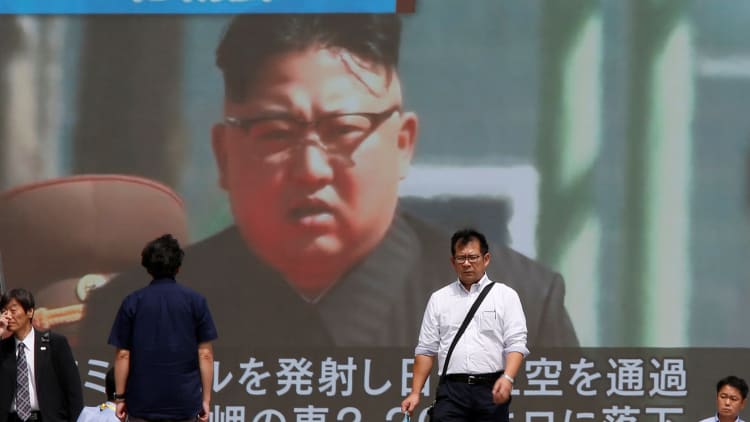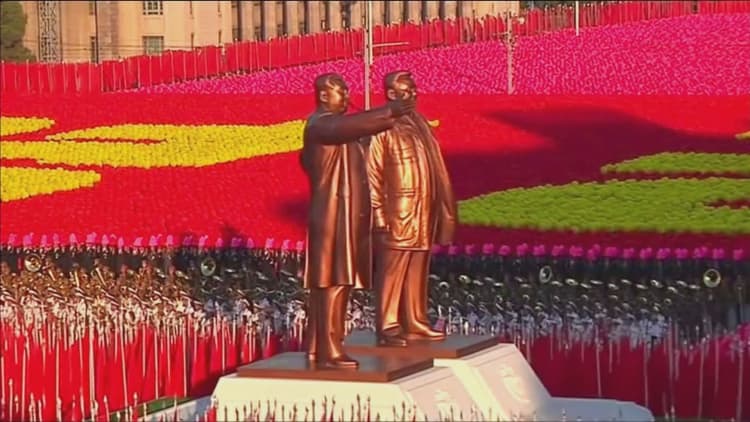
A retired U.S. general said a Pentagon war scenario showed a conventional war with North Korea could result in about 20,000 deaths per day in South Korea, according to the Los Angeles Times.
Meanwhile, a retired U.S. Navy admiral sees a 50/50 chance of a conventional conflict with North Korea although much less likelihood of a nuclear war.
On Monday, North Korea's foreign minister, Ri Yong Ho, accused President Donald Trump of declaring war against the hermit regime and threatened that the North has the right to shoot down U.S. strategic bombers even if they are flying in international airspace.
Last week, Ri told reporters the regime might detonate a hydrogen weapon in the Pacific. Up to now, the North's nuclear tests have been underground.
Pentagon spokesman Lt. Col. Christopher Logan told CNBC on Monday, "Obviously North Korea is a threat." And he pledged the U.S. military will defend "both U.S. homeland and our allies against that threat."
Defense experts expressed skepticism the North would have an easy time shooting down advanced U.S. military aircraft.
"North Korea's air defenses are not great," said Ian Williams, associate director of the Missile Defense Project at the Center for Strategic and International Studies, a Washington-based think tank. "That's actually one area of missile technology where they haven't made huge advances in the past few years."
Analysts told CNBC the North's new KN-06 surface-to-air missile system could provide some protection for the regime and looks like Russia's S-300 air defense system. That said, not a lot is known about KN-06's radar capabilities. It has been trotted out at military parades, and Pyongyang's state media declared the anti-aircraft weapon operational in May.
Over the weekend, the U.S. Air Force said B-1B Lancer bombers and F-15C Eagle fighter jets flew in international airspace over waters just east of North Korea. The U.S. flexing its military muscle follows heated rhetoric recently between North Korea's leader, Kim Jong Un, and Trump, who last week in an address at the United Nations said that the U.S. could "totally destroy North Korea."
The B-1B bombers flew from the U.S. Pacific territory of Guam, where the U.S. has military bases and an estimated 6,000 troops. Also, the U.S. has around 25,800 troops stationed in South Korea, as well as approximately 50,000 service members in Japan.
"Right now it's still a lot of words, and it's a lot of words by two leaders that tend to bluster a bit," Williams said. "One of them, particularly Kim Jong Un, if he feels that conflict is inevitable ... then his strategic position is one where he would gain a lot by taking the first move."
Ret. Navy Adm. James Stavridis, dean of the Fletcher School of Law and Diplomacy at Tufts University, put chances of a nuclear war with North Korea at 10 percent and the chance of a conventional conflict with the regime at 50/50, according to the Times.
The admiral told the paper a war could potentially start if North Korea fires a missile that strikes on Guam or lands near the U.S. territory. It could potentially result in the U.S. striking back against North Korea with Tomahawk cruise missiles, as it did on a Syrian government airbase after a chemical attack in April. And while Syria just took the blow, Kim Jong Un might respond more forcefully to avoid looking weak, including possibly firing artillery at U.S. military posts in South Korea.
Also, the Times said there's a possibility the North Korean dictator could resort to more drastic action, including even smuggling a nuclear weapon aboard a ship to a location where it could cause massive casualties. He also could use an aircraft to drop the weapon.
"We are closer to a nuclear exchange than we have been at any time in the world's history with the single exception of the Cuban missile crisis,'' Stavridis told the Times.
The paper said a Korean war could start with something such as "a relatively minor incident at the demilitarized zone ... or a provocation that develops into a conventional war and then escalates."
Nonetheless, some believe tension in the past after such incidents didn't produce outright war.
"Things are certainly very tense," said Dean Cheng, a defense expert and senior research fellow at the Heritage Foundation, the Washington-based conservative think tank. "The North Korea of right now is arguably seen as a real threat in a way that even in 2010 we didn't view it that way."
Experts say a lot of the North's military capabilities are ballistic missile-based weapons. Besides nuclear weapons, the North also is believed to have a large stockpile of chemical weapons.
According to Williams, the North's ballistic missiles are "use or lose assets" so its leader Kim would have an impetus to go first, which "ultimately raises the risk of conflict and the chance of miscalculation. It's hard to know what's going on in his mind, but that's my fear."
The recent expansion of the THAAD anti-missile system in South Korea could help reduce the threat of missiles, however, it probably won't help much in the greater Seoul area. About 25 million people, or half of the country's population, lives in the greater Seoul area.
The exact range of the Terminal High Altitude Area Defense system is believed to be up to 200 kilometers (124 miles), although THAAD was installed about 227 kilometers (or 135 miles) away in Seongju.
"South Korea has devoted a fair amount of effort to building shelters, conducting civil defense drills and things like that," Heritage's Cheng told CNBC. He added that there's no reason to assume the North Koreans would not try to hit apartment buildings or other civilian targets.
The CSIS expert said there's also a risk the U.S. could push the North Korean regime leader "too hard and over the brink in terms of paranoia."
The North's propaganda has threatened in recent months to attack the U.S. homeland with nuclear-armed missiles. The regime also has conducted at least two tests of intercontinental ballistic missiles, including one in July that experts said proved the North is capable of reaching half, if not most, of the continental United States, including major East Coast cities such as New York and Boston.
Even so, the threat to South Korea is especially alarming for Seoul residents since the city is close to the North Korean border. The North is said to have thousands of underground locations where it stores rockets and other weapons as well as tunnels that could allow it to quickly enter South Korea.
"They've had pretty much since 1953 to burrow and dig and tunnel," said Cheng.
The Heritage expert described how the North Koreans have dug "hardened artillery sites" that are essentially bunkers with armored doors with a slip to stick artillery tubes through. He said the regime has thousands of these along the Korean DMZ and within range of Seoul.
Nuclear weapons the North could use obviously bring added risks but even without them the loss of life could be significant.
A Pentagon war scenario estimated there would be about 20,000 casualties in South Korea each day in a conventional war, the Times report said, quoting Rob Givens, a retired U.S. Air Force brigadier general who was once stationed on the Korean peninsula.
"Too many people have the view that it would be like the invasion of Iraq or Afghanistan, or like combat operations in Libya or Syria, but it wouldn't be remotely that," Givens told the Times.
"There is only one way that this war ends," he added. "With North Korea's defeat — but at what cost?"
Williams said the 20,000 deaths per day estimate seems a realistic estimate particularly for "the very beginning of the war, particularly if there wasn't much preparation or warning time."
Added Williams, "The scale of an artillery barrage [from the North] initially would be pretty massive. You'd be looking at several thousand rockets and artillery pieces being fired over the course of several hours."
Experts add that the use of chemical or biological weapons by the North, though, could produce even heavier losses in South Korea. By some estimates, the hermit regime has the world's third-largest chemical weapons stockpile — up to 5,000 metric tons of chemical agents.
Logan, the Pentagon official, declined to comment when CNBC asked about estimated casualties on the South Korean side.
The South is seen as particularly vulnerable to a saturation attack, using short-range Scud and other missiles targeting Seoul. There's also the possibility of an attack using submarine-launched ballistic missiles, with a recent Japanese report indicating the North is close to completing a larger submarine capable of firing multiple missiles.
Read the full article in the Los Angeles Times.
WATCH: US-South Korean war games could further inflame Pyongyang



